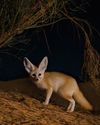GARDENERS OF THE FOREST
BBC Wildlife
|April 2022
How a living fossil is making modern Costa Rica greener

ABOUT THE AUTHOR
Lucy Cooke is a broadcaster and zoologist, and writes the regular column Female of the Species for BBC Wildlife (flick back to page 27). She is the author of Bitch: A Revolutionary Guide to Sex, Evolution and the Female Animal (Doubleday, £20).
CONSERVATION heroes come in all shapes and sizes, but none as mysterious as the tapir. Latin America's largest native land mammal is a peculiar-looking beast that swims like a hippopotamus and climbs like a goat. It also eats like an elephant, using an elongated prehensile snout to pluck the tastiest fruit and leaves and deliver them into a decidedly equine mouth.
The tapir appears to have been cobbled together from an eclectic assortment of random beasts. The overall effect is quite prehistoric, which is fitting: the tapir hasn't really changed in more than 35 million years, earning it the title of living fossil. Its closest living relative is the rhinoceros. The tapir shares a profoundly shy nature with its distant cousin, which has ensured this jungle giant's secrets have been well-kept - until now. Research is revealing surprising insights into the tapir's private life, including its unlikely role as a four-footed eco-warrior with a smelly secret weapon.

I've always loved odd animals and frankly they don't get much odder than the tapir. So when I got the chance to travel to Costa Rica in late 2021 and hang out with local conservation biologist Esteban Brenes-Mora, AKA "the tapir guy", I jumped at the chance.
このストーリーは、BBC Wildlife の April 2022 版からのものです。
Magzter GOLD を購読すると、厳選された何千ものプレミアム記事や、10,000 以上の雑誌や新聞にアクセスできます。
すでに購読者ですか? サインイン
BBC Wildlife からのその他のストーリー

BBC Wildlife
"I was terrified the elephant would ram us"
African elephant in Kenya
2 mins
January 2026

BBC Wildlife
ALL YOU EVER NEEDED TO KNOW ABOUT THE Fennec fox
THE FENNEC FOX IS THE SMALLEST fox in the world, with a body length that can be as little as 24cm.
3 mins
January 2026

BBC Wildlife
INTO THE PLASTISPHERE
A unique synthetic ecosystem is evolving in our oceans – welcome to the plastisphere
7 mins
January 2026

BBC Wildlife
“More than half of all animal life exists in a parasitic relationship, and all life lives in symbiosis”
Our survival depends on species evolving to live together - but some relationships take dark turns
7 mins
January 2026

BBC Wildlife
Are animals able to dream?
SLEEP IS A MYSTERIOUS THING. FOR A long time, we weren't sure why we do it.
1 mins
January 2026

BBC Wildlife
Does a cuckoo know it's a cuckoo?
ABSURD LITTLE BIRDS ACROSS THE world lay their eggs in the nests of other species, leaving the hapless parents to raise a changeling at the expense of their own offspring.
2 mins
January 2026

BBC Wildlife
Orcas killing young sharks
Juvenile great whites are easy prey for orca pod
1 mins
January 2026

BBC Wildlife
Ocean goes on tour
Acclaimed film touring the UK, backed by live orchestra and choir
1 min
January 2026

BBC Wildlife
Feisty bats hunt like lions
Winged mammals use a 'hang and wait' strategy to take down large prey
1 mins
January 2026

BBC Wildlife
SNAP-CHAT
Richard Birchett on magical merlins, wily coyotes and charging deer
2 mins
January 2026
Translate
Change font size

